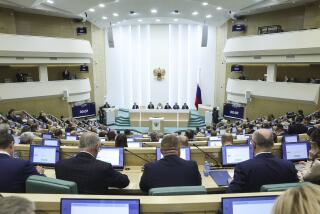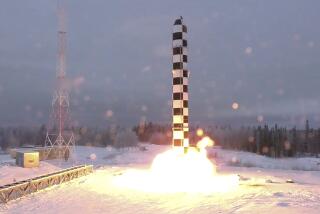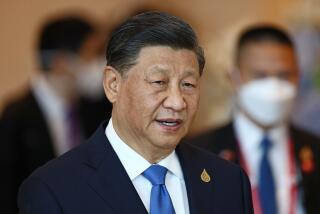China Plans ‘a Few More’ Nuclear Tests : Asia: Effort aims to fend off ‘blackmail.’ Beijing also considers computer simulations.
- Share via
BEIJING — China plans to conduct “a few more” underground nuclear tests during the next two years, or at least until an international test ban treaty is reached, a senior official in the Foreign Ministry said Thursday.
“We need a little more nuclear testing just to show that we can do it, so no one will try to blackmail us,” said the official during an unusually candid discussion with a few Western reporters. The “blackmail” reference dates to the Korean War, during which China claims that the United States threatened it with nuclear attack in what it termed at the time “nuclear blackmail.”
The official, who has an extensive background in arms control negotiations, also said China is interested in pursuing a proposal by U.S. Secretary of Defense William J. Perry that it substitute computer simulation for nuclear tests.
However, he said, the computer simulation procedure, while an attractive idea among the five major nuclear powers, faced likely opposition from non-nuclear countries that view it as another form of nuclear proliferation.
“Whereas it might be technically feasible, it may not be politically feasible,” the official said.
Perry, who visited China earlier this week, said in a news conference Tuesday that he had discussed with senior Chinese officials “ways of eliminating the need for testing (that) had to do with computer simulation techniques.”
“We discussed the possibility of exchanging information in that field,” Perry said. “To the extent we can do that without compromising security, I think that would be a positive step forward.”
One objective the U.S. defense secretary set as part of his four-day visit, which ended Wednesday, was to dissuade the Chinese from further nuclear testing.
Since Oct. 5, 1993, the Chinese have conducted three underground nuclear tests, breaking a moratorium observed by the four other nuclear powers--the United States, Britain, France and Russia. The most recent blast, estimated at between 40 and 150 kilotons, took place at China’s remote Lop Nor testing ground in Xinjiang province on Oct. 6.
Officials in Beijing argue that since China has the fewest warheads among the nuclear powers, it needs the testing to close the technological gap between it and the four other countries. According to arms control specialists, China’s nuclear forces are made up of about 300 warheads mounted on intermediate- and long-range missiles, bombers and submarines.
Some arms control specialists speculate that the latest round of testing is aimed at improving China’s submarine nuclear weapons system, the only one in its arsenal capable of threatening targets in the United States.
U.S. officials are encouraged by Chinese pledges to halt all testing by 1996, or even before, if a Comprehensive Test Ban Treaty is reached in Geneva. On Thursday, the senior Foreign Ministry official reaffirmed this position.
“China has made a political decision not to conduct nuclear tests after the signing of the Comprehensive Test Ban Treaty,” the official said.
However, he suggested that the 1996 deadline for signing the treaty may not be firm. “It’s an artificial date just to show there is political will,” he said.
The biggest block to the conclusion of the treaty, the official said, is U.S. opposition to a statement promising that it will not be the first party to use nuclear weapons in a conflict.
“A U.S. commitment on non-first-use, as well as the commitment of other powers, would certainly help in China’s participation,” the official said.
The briefing for foreign reporters was the latest in a series of steps by the Chinese government to be more open about its nuclear programs.
More to Read
Sign up for Essential California
The most important California stories and recommendations in your inbox every morning.
You may occasionally receive promotional content from the Los Angeles Times.










